A drip-irrigation system—when properly designed, maintained and operated—can be a production asset for a small farm. Using drip irrigation for profitable vegetable production requires an understanding of several basic engineering and horticultural concepts and their application. The goals of this publication are to present the principles behind drip irrigation and some practical guidelines for successful and profitable use of drip irrigation.
1. Overview of Drip Irrigation
1.1 What is drip irrigation?
Drip irrigation (also known as trickle irrigation or micro-irrigation) is an irrigation method that allows precisely controlled application of water and fertilizer by allowing water to drip slowly near the plant roots through a network of valves, pipes, tubing, and emitters. Plasticulture is the combined use of drip irrigation, polyethylene mulch and raised beds. Greatest productivity and earliness may be achieved in vegetable production by combining plasticulture with the use of transplants.
1.2 Is drip irrigation adapted to all operations?
Drip irrigation is not a silver bullet; it may not be applicable to all farms. Yet, when properly managed, it is a valuable production technique that may reduce labor and production costs while improving productivity. Small farmers considering the use of drip irrigation should evaluate both the advantages and disadvantages of this system to determine the benefits of drip irrigation for their operation.
1.3 What are the main advantages of drip irrigation?
Reduced water use: Because drip irrigation brings the water to the plant root zone and does not wet the entire field, drip irrigation typically requires half to a quarter of the volume of water required by comparable overhead-irrigation systems.
Joint management of irrigation and fertilization: Drip irrigation can improve the efficiency of both water and fertilizer. Precise application of nutrients is possible using drip irrigation. Hence, fertilizer costs and soluble nutrient losses may be reduced with drip irrigation. Nutrient applications may also be better timed to meet plant needs.
Reduced pest problems: Weed and disease problems may be reduced because drip irrigation does not wet the row middles or the foliage of the crops as does overhead irrigation.
Simplicity: Polyvinyl chloride (PVC) and polyethylene parts are widely available in several diameters and are easy to assemble. Many customized, easy-to-install connectors, endcaps, and couplers are available in different diameters. Cutting and gluing allows for timely repairs.
Low pumping needs: Drip systems require low operating pressure (20–25 psi at field entrance, 10–12 psi at the drip tape) compared to overhead systems (50–80 psi). Many existing small pumps and wells may be used to adequately irrigate small acreage using drip systems.
Automation: Drip-irrigation application may be simply managed and programmed with an AC- or battery-powered controller, thereby reducing labor cost.
Adaptation: Drip systems are adaptable to oddly shaped fields or those with uneven topography or soil texture, thereby eliminating the underutilized or non-cropped corners and maximizing the use of available land.
Production advantages: Combined with raised beds, polyethylene mulch, and transplants, drip irrigation enhances earliness and crop uniformity. Using polyethylene mulch also increases the cleanliness of harvested products and reduces the risk of contamination with soil-born pathogens. Reflective mulches further help reduce the incidence of viral diseases by affecting insect vectors, such as thrips, whiteflies, or aphids.
1.4 What are the disadvantages of drip irrigation?
Drip irrigation requires an economic investment: Drip-irrigation systems typically cost $500–$1,200 or more per acre (Table 1). Part of the cost is a capital investment useful for several years, and another part is due to the annual cost of disposable parts. Growers new to drip irrigation should start with a relatively simple system on a small acreage before moving to a larger system.
Drip irrigation requires maintenance and high-quality water: Once emitters are clogged or the tape is damaged, the tape must be replaced. Water dripping from an emitter and the subsequent wetting pattern are hard to see, which makes it difficult to know if the system is working properly. Proper management of drip irrigation requires a learning period.
Water-application pattern must match planting pattern: If emitter spacing (too far apart) does not match the planting pattern, root development may be restricted and/or plants may die.
Safety: Drip tubing may be lifted by wind or may be displaced by animals unless the drip tape is covered with mulch, fastened with wire anchor pins, or lightly covered with soil.
Leak repair: Drip lines can be easily cut or damaged by other farming operations, such as tilling, transplanting, or manual weeding with a hoe. Damage to drip tape caused by insects, rodents, or birds may create large leaks that also require repair.
Drip-tape disposal causes extra cleanup costs after harvest: Planning is needed for drip-tape disposal, recycling, or reuse.
1.5 How does my drip-irrigation system affect organic certification?
Growers considering certified organic production should first become familiar with the National Organic Program (NOP) (http://www.ams.usda.gov/NOP/indexIE.htm) and the principles of organic production (Ferguson, 2004a,b; Treadwell, 2006). All production inputs used in certified organic production must follow the National List of Allowed and Prohibited Substances (Code of Federal Register [CFR] 205.600 of the National Organic Program). Drip irrigation itself (standard drip tape) is allowed. Products typically used with drip irrigation in conventional production systems that may or may not be allowed in certified organic production may be classified in four groups: water, products for drip-irrigation maintenance (algaecides, disinfectants and acids), fertilizers, and pesticides (Table 2).
The design and maintenance of a drip-irrigation system should be clearly outlined in the Organic System Plan (farm plan required for certification), including any inputs that will be delivered through the drip-irrigation system. In all cases, contact your certifying agency before using a product to confirm that use of that product will not jeopardize organic certification.
Drip-irrigation water. In most cases, groundwater, surface water, rainwater, and potable water may be used in certified organic production. In some instances, the certifying agency may request a water analysis.
Products for drip-irrigation maintenance. Within stated restrictions (see Table 2), CFR 205.601 of the NOP lists the following substances as allowable as synthetic algaecide, disinfectant, and sanitizers: (1) alcohols, including (a) ethanol and (b) isopropanol; (2) chlorine materials [except that residual chlorine levels in the water shall not exceed the maximum residual disinfectant limit under the Safe Drinking Water Act], including (a) calcium hypochlorite, (b) chloride dioxide, (c) sodium hypochlorite; (3) hydrogen peroxide; and (4) soap-based algaecide/demisters. Additionally, under NOP Rule CFR 205.105, citric acid is allowed when irrigation water needs to be acidified. (See Section 4.2 of this paper for why and how much.) However, other compounds commonly found in ready-to-use drip-irrigation cleaners and maintenance products and typically used in conventional systems (see Section 4.2, below) are prohibited in certified organic production.
Fertilizers and pesticides. No specific ruling prohibits NOP-compliant products from being distributed through a drip-irrigation system. Plans to use drip irrigation to distribute fertilizers and/or pesticides should be clearly outlined for approval in the Organic System Plan. When in doubt, consult first with your certifying agency. All growers are obligated to follow state and federal guidelines for injecting inputs through irrigation systems (see Section 2).
1.6 Is drip irrigation considered a Best Management Practice?
Yes. Best Management Practices (BMPs) are cultural practices that help reduce the environmental impact of production while maintaining or increasing productivity. The BMP program for vegetables grown in Florida is described in "Water quality/quantity best management practices for Florida vegetable and agronomic crops" (Florida Department of Agriculture and Consumer Services, 2005). The BMP manual describes all the BMPs that apply to vegetable production, as well as a decision-tree to identify the BMPs that apply to each operation and guidelines for completing and submitting the Notice of Intent to Implement (Gazula et al., 2007).
Participation in the Florida BMP program and the organic certification program are two separate processes. Vegetable growers who are enrolled in the statewide BMP program receive three statutory benefits: (1) a waiver of liability from reimbursement of cost and damages associated with the evaluation, assessment, or remediation of nitrate contamination of groundwater (Florida Statutes [F.S.] 376.307); (2) a presumption of compliance with water-quality standards (F.S. 403.067 (7)(d)), and (3) eligibility for cost-share programs (F.S. 570.085 (1)).
Specific vegetable BMPs that address drip irrigation include BMP 33 "Optimum fertilization application/management", BMP 34 "Chemigation /fertigation", BMP 39 "Irrigation system maintenance and evaluation", and BMP 47 "Plasticulture farming". Additional BMPs involving drip irrigation include BMP 26 "Soil testing/soil pH", BMP 36 "Water supply" and BMP 40 "Irrigation scheduling". BMP implementation requires record keeping (see Table 3). When properly implemented, all BMPs that apply to drip irrigation help to increase efficiency in the use of water and nutrients.
1.7 What is the best way (or best unit) to express irrigation rates when drip irrigation is used?
For irrigation systems that entirely wet the field (overhead or flood systems), irrigation rates are typically expressed in inches. This unit of measurement represents a vertical amount of water (or a height). The actual "volume" of water is calculated by multiplying the height of water by the field surface. For example, 1 acre inch is the volume of water present on a 1-acre field with a 1-inch depth: 1 acre inch = 27,154 gallons.
Because drip irrigation does not wet the entire field, expressing drip-irrigation volumes as a height of water poorly represents reality. Instead, drip-irrigation volumes should be expressed in gallons-per-100-linear-foot-of-drip-tape. In some cases, drip-irrigation volumes can be converted to and from water heights by considering the relative surface of the field under plastic mulch. For example, the relative surface under plastic mulch of a 1-acre field with 30-inch-wide beds of 4-ft centers is 62.5% (2.5 ft/4 x 100). Hence, if 0.5 acre inch needs to be applied to that field through a drip-irrigation system, the total volume of water needed is 8,484 gallons (27,150 / 2 x 0.625). Because in a 1-acre field with beds of 4-ft centers there are 10,890 linear-bed-feet of plastic, the drip-irrigation rate should be reported as 78 gallons/100 ft (8,484/108.90). If a drip tape with a 24-gal/100-ft/hr flow rate is used, it will take 3 hours and 15 minutes to apply this amount of water (78/3 = 3.25 hrs).
In heavy soil, it is reasonable to assume that a drip tape installed in the middle of the bed will be sufficient to wet the entire bed width. However, research has shown that, on Florida's sandy soils, the wetted width seldom exceeds 18 inches (1.5 ft) when a single drip tape is used. Hence, the assumption made in the calculation above—that the entire bed width is wetted (and, therefore, irrigated)—is not correct for most drip-irrigation systems in Florida. The actual wetted width should be used in place of the bed width.
2. Components of a Drip-Irrigation System
The type and sequence of components in a drip-irrigation system are typically the same for all field sizes. Yet, based on field size (and water need), component sizes (diameter) may vary. Larger components tend to be more expensive. The backflow-prevention devices—comprised of two check valves and the lowpressure drain, also known as "anti-siphoning device"—are the only components required by Florida law (FS 487.021 and 487.055 and Florida Department of Agriculture and Consumer Services Rule 5E-2.030) when fertilizer or chemicals are injected into the system (see Section 2.6, below). The actual selection of a specific component (with the exception of the backflow-prevention device) generally needs to be made on a case-by-case basis. (See Table 11 for additional readings on this topic.) The following is a brief description of the main components of a typical drip-irrigation system.
2.1 Water Source
Common water sources for drip irrigation are surface water (pond, river, and creek), groundwater, and potable water (from municipality, county, or utility company) (Figure 1). Use the water source that will provide the largest amount of water of greatest quality and lowest cost. Potable water is of high, constant quality, but is by far the most expensive.
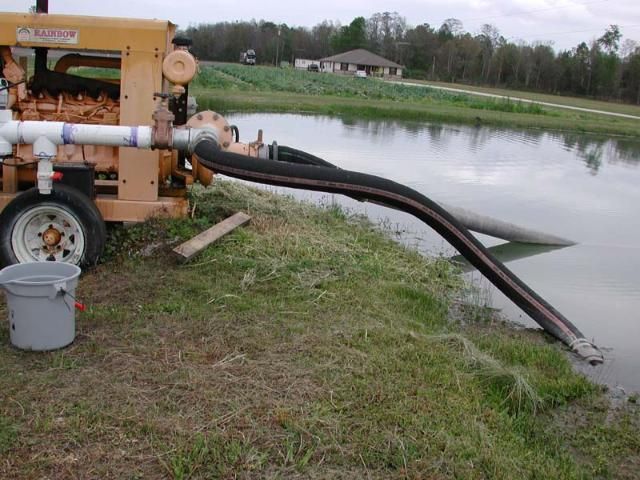
Credit: Eric Simonne.
2.2 Pumping System
The role of the pumping system is to move water from the water source to the field through the distribution system. Pumping systems may be classified as electric powered systems, gas/diesel powered systems, and gravity systems. Gas/diesel pumps offer the greatest versatility in isolated fields (Figure 2).
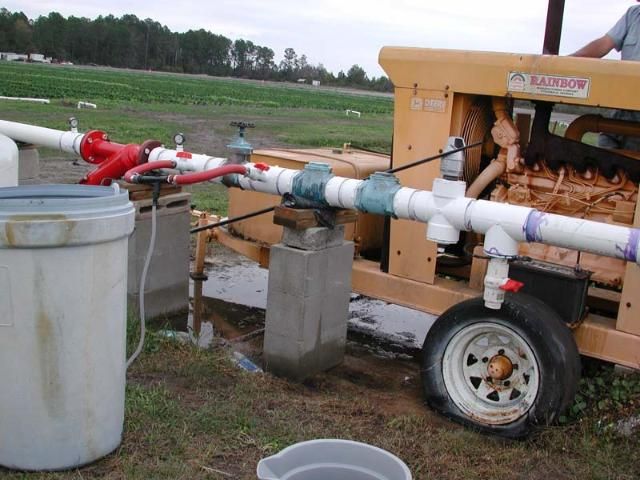
Credit: Eric Simonne.
2.3 Distribution System
The role of the distribution system is to convey the water from the source to the field. Distribution systems may be above ground (easily movable) or underground (less likely to be damaged). Pipes are most commonly made of PVC or polyethylene plastics. Aluminum pipes are also available, but are more difficult to customize, cut, and repair. The size and shape of the distribution system may vary widely from field to field and from farm to farm.
2.4 Drip Tape (or Drip Tube)
The drip-irrigation system delivers water to each plant through a thin polyethylene tape (or tube) with regularly spaced small holes, called emitters. Selection of drip tape should be based on emitter spacing and flow rate. The typical emitter spacing for vegetables is 12 inches, but 8 inches or 4 inches may be acceptable. Dry sections of soil may develop between consecutive emitters when a wider emitter spacing (18 inches) is used on sandy soils. Flow rates are classified into low flow (<20 gal/100 ft/hr), medium flow (20 to 30 gal/100 ft/hr) and high flow (>30 gal/100 ft/hr). The risk of emitter clogging is generally higher with the lower-flow drip tapes.
The following equivalent units are commonly used to report flow rates: gal/100 ft/hr or gallons/emitter/hr. For example, with a 12-inch emitter spacing, 24 gal/100 ft/hr = 24/100 = 0.24 gal/emitter/hr. In the field, drip-irrigation tape should be installed with emitters upward (looking up) to prevent clogging from sediment deposits settling in the emitters between irrigation events. Drip tapes are widely available from several manufacturers
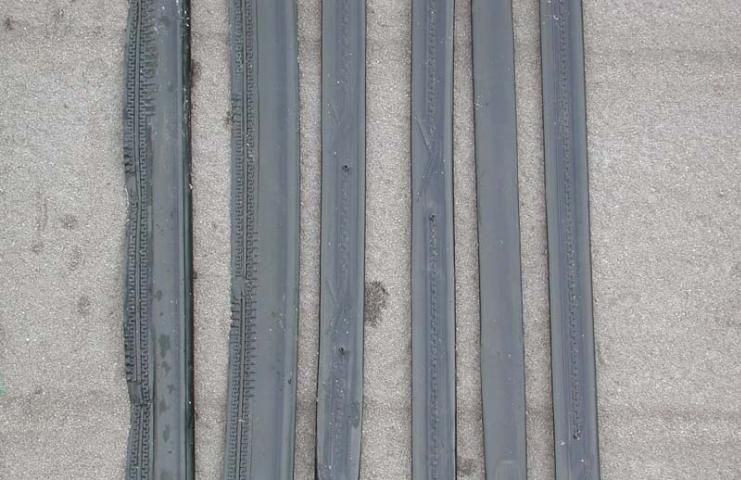
Credit: Eric Simonne.
2.5 Injectors
Injectors allow the introduction of fertilizer, chemicals, and maintenance products into the irrigation system. Florida law requires the use of an anti-siphoning device (also called backflow-prevention device) when fertilizer, chemicals, or any other products are injected into a drip-irrigation system (Figure 4). Backflow-prevention devices ensure the water always moves from the water source to the field. The devices prevent chemicals in the water from polluting the water source.
The most common injectors used with small drip-irrigation systems are the Venturi (or Mazzei) injector (Figure 4) and the Dosatron (Figure 5). Because Venturi injectors involve no moving parts and are less expensive, they are commonly used on small farms (Table 2). The injector is typically located as close as possible to the irrigation zone, but before the filter.
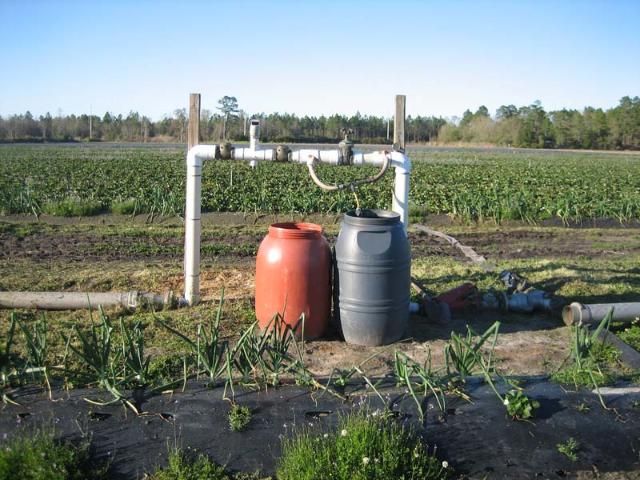
Credit: Eric Simonne.

Credit: Eric Simonne.
2.6 Filtration System
Because drip-irrigation water must pass through the emitters, the size of the particles in the water must be smaller than the size of the emitter to prevent clogging. Nearly all manufacturers of drip-irrigation equipment recommend that filters be used. The manufacturer generally will not honor warranties unless filters are used.
The filtration system removes "large" solid particles in suspension in the water. Different types of filters are used based on the type of particles in the water. Media filters (often containing angular sand) are used with surface water when large amounts of organic matter (live or dead) need to be filtered out. Screen filters or disk filters may be used with groundwater (Figure 6). A 200-mesh screen or equivalent is considered adequate for drip irrigation. When the water contains sand, a sand separator should be used.
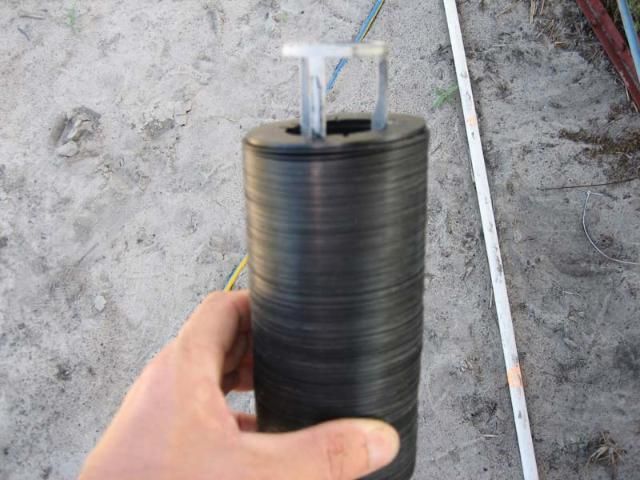
Credit: Eric Simonne.
Rapid clogging may occur when no filter or the incorrect type of filter is used. A filter needs to be cleaned when the difference in pressure across the filter (measured before and after the filter) is greater than 5–8 psi. A drip-irrigation system should never be operated without a filter even if the filter requires frequent cleaning. Failure to use a filter will result in clogged drip-tape emitters, often resulting in poor uniformity and sometimes in crop loss. The filter should be cleaned as often as needed. Efforts should be made to understand the cause of the rapid clogging, and remediation for the problem should be developed.
The presence of the filter after the point of fertilizer injection means totally soluble fertilizers must be used. Otherwise fertilizer particles may contribute to filter clogging. Conventional growers may use two types of fertilizer materials: ready-to-use true solutions or dissolved granular fertilizer. Ready-to-use solutions are easily injected. However, granular fertilizers are sometimes coated with a thin layer of oil to prevent dusting. Upon dissolution of the fertilizer granules, an oily film may form at the surface of the solution. Injecting the oily film together with the fertilizer may contribute to filter and emitter clogging. Certified organic fertilizers are seldom true solutions (they may be suspensions or dilute colloidal solutions), and may also contribute to filter clogging. Consequently, the actual fertilizer rate applied may be reduced by the amount of fertilizer particles trapped by the filter. In both cases, small-scale trials may be needed to assess the clogging risk of each fertilizer material used.
2.7 System Controls
System controls are devices that allow the user to monitor how the drip-irrigation system performs. These controls help ensure the desired amount of water is applied to the crop throughout the growing season.
Pressure regulators, installed in-line with the system, regulate water pressure at a given water flow (Figure 7), thereby helping to protect system components against damaging surges in water pressure. Pressure surges may occur when the water in the pipe has a velocity >5 feet /second ("water hammer") or when water flowing in the pipe has no avenue for release due to a closed valve or a clog in the pipe.
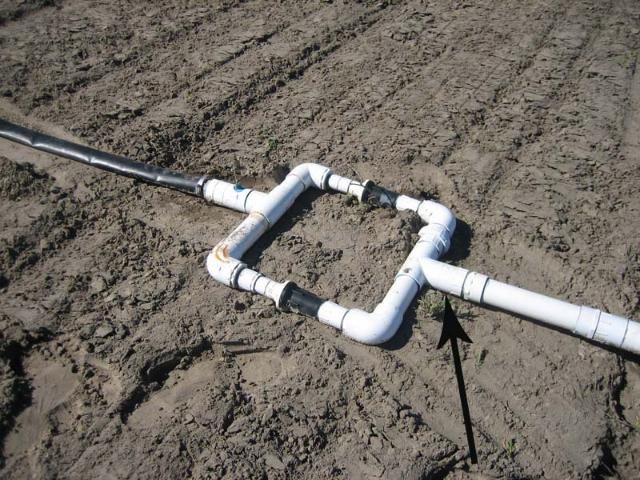
Credit: Eric Simonne.
Water meters monitor and record the amount of water moving through a pipe where the water meter is installed (Figure 8). When a stopwatch is used together with a water meter, it is possible to determine the water flow in the system in terms of gallons-per-minute.
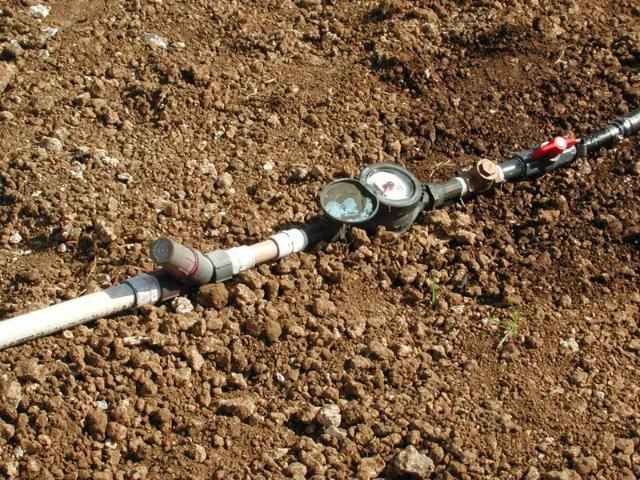
Credit: Eric Simonne.
Pressure gauges monitor water pressure in the system and ensure operating pressure remains close to the recommended or benchmark values. Based on where the pressure gauge is installed, it will measure water pressure in a various ranges, from 0–100 psi near the pump to 0–20 psi at the end of drip tape (Figure 9). Pressure gauges may be installed at set points (near the pump, before and after the filter, near the field; see Figure 10). They can also be mounted as portable devices and installed temporarily at the end of a drip tape.
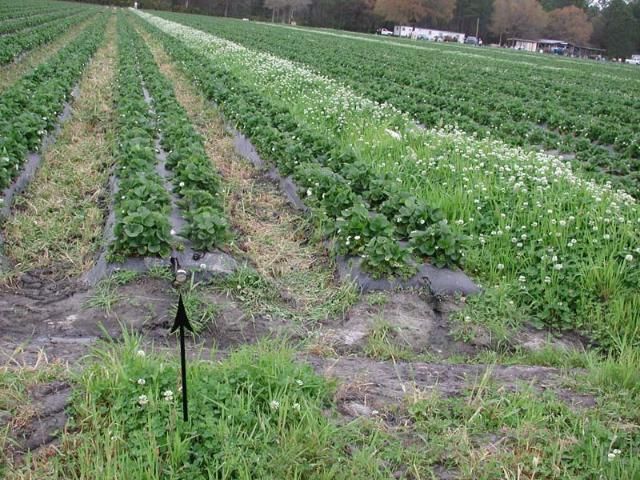
Credit: Eric Simonne.
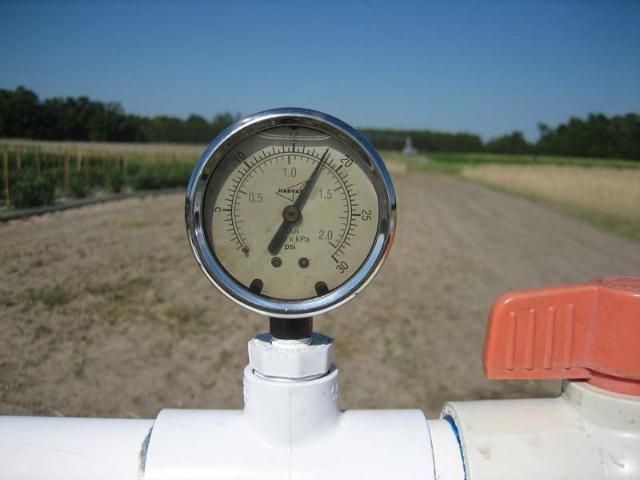
Credit: Eric Simonne.
Soil-moisture-measuring devices (such as tensiometers, capacitance probes, or Time Domain Reflectometry probes) are used to measure soil moisture in the root zone of the crop (Muñoz-Carpena 2004). The Florida Extension Service recommends maintaining soil-water tension between 8 and 12 centibars 6 inches away from the drip tape and at the 12-inch depth.
Electrical timers connected to solenoid valves (Figure 11) may be used to automatically operate a drip-irrigation system at pre-set starting and ending operating times of day.
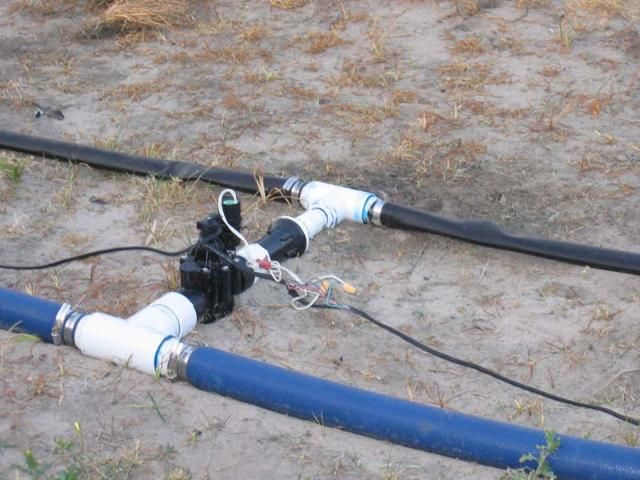
Credit: Eric Simonne.
3. Tips for Design and Layout
Irrigation engineers are trained and certified to properly design drip-irrigation systems. Relying on their expertise will pay off in the long run. Many small-scale growers abandon drip irrigation because of poor performance of flawed designs or inadequately modified designs. Do not hesitate to ask for professional help when designing your drip-irrigation system or when planning major modifications to an existing system. The following section presents the basics of system design, but is not a substitute for the professional services of a qualified engineer.
3.1 Planning a Drip Irrigation System: Horticultural Considerations
The goal of drip irrigation is to bring water to the crop. The main parameters that determine crop water use are the type of crop planted and row spacing. A drip irrigation system should be able to supply 110%–120% of crop water needs. In other words, the system should be slightly oversized. In designing a drip-irrigation system, it is common to consider that vegetable crops ordinarily need approximately 1.5-acre-inches of water for each week of growth or approximately 20-acre-inches of water per crop. Actual crop water use will be more or less than this amount, depending on weather and irrigation efficiency.
3.2 Planning a Drip Irrigation System: Design Considerations
Start with what is already available—the water source or the field. If a water source is already available (pond or well), the amount of water available may be used to calculate the maximum size of each irrigation zone (Table 4).
If no water source is available, the amount of water needed by the crop—based on the size of the planted area—may be used to calculate the type of well or pond size needed (Table 5).
Lay out of beds and rows. Because differences in altitudes affect water pressure, it is preferable to lay out beds perpendicular to the slope. This arrangement of rows is called "contour farming" (Figure 12).
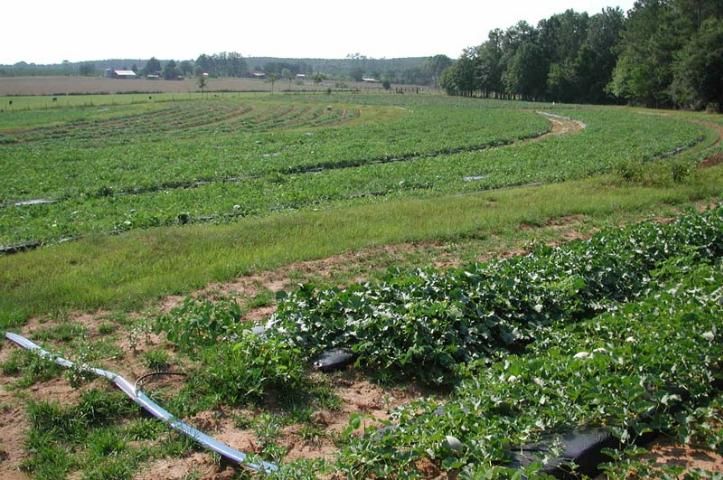
Credit: Eric Simonne.
Pipe sizing. Larger-diameter pipes are more expensive than smaller-diameter pipes, but larger-diameter pipes carry more water. All delivery mains and secondary lines should be sized to avoid excessive pressure losses and velocities and should be able to withstand a pressure of 80 psi.
Excessive pressure losses result in a large difference in pressure from the pressure level at the beginning of the line compared to the pressure level at the end of the line. Since the flow rate of the emitters is usually a function of water pressure, the water application at the beginning of the line may be very different from the water application at the end of the line. This difference will result in irregular water application on the crop.
Excessive water velocities (>5 ft/sec) in the lines—the result of a too-small diameter—are likely to create a water hammer (pressure wave), which can damage the delivery lines. Growers should be aware of the maximum acreage that can be irrigated with different pipe sizes at a water velocity of 5 feet/second (Table 6).
The maximum length of drip tape should be based on the manufacturer's recommendation and the actual terrain slope. Typically 400–600 feet are maximum values for drip-tape length. Excessive length of laterals will result in poor uniformity and uneven water application. When the field is longer than 400–600 feet, consider placing the secondary (submain) line in the middle of the field—rather than at the end—and connect drip tape on both sides.
3.3 Layout Tips
A Y-connector is convenient on a drip system connected to a hose bibb because a garden hose can be connected to the other side.
To evaluate source flow rate, run water full force from an outside faucet and note the number of seconds required to fill a bucket of known volume. Calculate the gallons of flow per hour (gph) by dividing the bucket size in gallons by the number of seconds required to fill it, then multiply by 3600 seconds for gallons-per-hour:
System flow rate (in gph) = Bucket volume (in gallons) /time needed to fill (in seconds) x 3,600 seconds per hour
The maximum flow is considered to be 75% of the flow-rate measure above. Maximum flow is the largest number of gallons available for use at one time while operating a drip-irrigation zone.
Use goof plugs to plug holes in the mainline that are no longer needed due to system modification.
Common setup mistakes include not installing a filter or a pressure reducer, using excessively high lengths of mainline, and/or adding too many drip emitters.
Zones should be approximately the same size throughout your drip-irrigation system. Variation in zone sizes will reduce the efficiency of pump operation. When all zones are of the same size, pipe sizes and system cost will normally be minimal. The length of the mainline should not exceed 200 feet in a single zone.
Pressure regulators may be required if the pressure produced by the pump is too large or if zones vary greatly in size. If the pump was sized for a previously existing sprinkler system, it would likely operate at pressures that are excessive for the components of a drip system. If the system consists of different size zones, the pump must deliver the amount of water required in the largest zone at the pressure required by the tape used for lateral lines. If some zones are significantly smaller, the pump will produce higher pressure at the smaller discharges required by these zones. This pressure must be reduced by pressure regulators to the pressure-level required by the drip tape in the lateral lines.
4. Drip System Maintenance and Operation
The goal of drip-irrigation maintenance is to preserve the high uniformity of water application allowed by drip irrigation. A successful program of maintenance for a drip-irrigation system is based on the prevention-is-the-best-medicine approach. It is easier to prevent a drip tape from clogging than to "unclog" it or replace it. See Table 11 for additional readings on this topic.
4.1 Water Sampling for Drip Irrigation
An essential part of drip-irrigation management is determining water quality through water testing. Water testing will help determine water chemical composition, pH, and hardness (Table 7). These parameters have direct implications on chlorination, acidification, and filtration needs for irrigation water. Analyses performed by the UF/IFAS Extension Soil Testing Laboratory (UF/IFAS ESTL) determine pH, electrical conductivity, Ca, Mg, Fe, Mn, Na, Cl, hardness, total carbonates, and suspended solids. (A sample water test information sheet is available at https://edis.ifas.ufl.edu/pdffiles/SS/SS18400.pdf.) These tests are designed to test water suitability for irrigation; they do not indicate whether water is suitable for human consumption.
4.2 The Prevention-Is-the-Best-Medicine Maintenance Program for Drip Irrigation
This maintenance program is based on filtration, chlorination/acidification, flushing, and observation (see Table 8). Filters were described in section 2.5, above. Chlorination and acidification go together.
Chlorination consists of the introduction of a chlorinating compound (most often chlorine gas or sodium hyprochlorite) that produces hypochlorous acid (HOCl). In its non-dissociated form, hypochlorous acid oxidizes organic matter and precipitates iron and manganese.
The chlorination point should be placed before the main filters so the precipitates that form by the chlorination can be removed from the water. In Florida, most groundwater is alkaline (pH up to 8.4). The proportion of hypochlorous acid in the non-dissociated form (HOCl) is significantly greater at lower pH. Hence, acidification makes chlorination more efficient. In conventional production, hydrochloric acid (HCl and also called muriatic acid), sulfuric acid, or phosphoric acid may be used.
The amount of acid and chlorine needed to achieve a 1- or 2-ppm free chlorine concentration at the end of the line may be calculated by following the direction provided in EDIS Publication CIR1039 Treating Irrigation System with Chlorine. When applied correctly, the small amount of chlorine needed for drip-tape maintenance will be harmless to the crop grown in the soil.
Water acidification may be a challenge in certified organic production because NOP standards allow only acetic acid, citric acid, peracetic acid, and other natural acids for use as a cleaner for drip-irrigation systems. It may take large, unpractical, and expensive amounts of these acids to significantly reduce water pH.
Certified organic growers have three alternative options for drip-tape maintenance. First, chlorination may be done without acidification although this is less efficient and will require more product. Second, when economical and feasible, certified organic growers can choose to use potable water for drip-tape maintenance. Potable water may have a lower pH than well water, but analyses of both waters are needed to make this assessment. Third, non-chlorine-based products—such as natural chelating agents, hydrogen peroxide, or ozone—may be used to oxidize organic matter in the water. When in doubt, however, consult with your certifying agency for an acceptable plan for maintenance of your drip irrigation system.
Flushing may be accomplished automatically at each irrigation cycle when self-flushing end caps are used. Additional labor is required for flushing when the drip tape is tied or capped. Flushing may also be achieved by increasing pressure so to temporarily increase water velocity in the drip tape to 4–6 ft/sec. Flushing takes all the precipitates and slime that may develop outside of the drip tape.
Observation and record keeping are needed throughout the season to ensure that the performance of the drip-irrigation system does not change. Measure pressure and flow, including how these change throughout the season (Table 9).
4.3 Scheduling Drip Irrigation
An adequate method of irrigation scheduling is needed to reduce water needs, maximize crop yield and uniformity, and reduce nutrient movement below the root zone.
Scheduling irrigation consists of knowing when to start irrigation and how much to apply. A complete irrigation-scheduling program for drip-irrigated vegetables includes a target rate of water application adjusted to weather demand and plant age (Table 10), as well as a measurement of soil moisture, an assessment of rainfall contribution, a rule for splitting irrigation, and detailed record keeping (Tables 3 and 11). The actual size of the wetted zone may be visualized by injecting a soluble dye into the water and digging the soil profile (Simonne et al., 2005).
Because drip irrigation does not wet the entire field, the best unit for expressing crop water needs and irrigation amounts is volume-of-water-per-length-of-row, such as gallons-per-100-feet (gal/100 ft), which is the most commonly used unit. Vertical amounts of water (expressed in inches; 1 acre inch = 27,154 gallons) are commonly used with overhead and seepage irrigation, but should not be used for drip irrigation. (See Table 11 for additional readings on this topic.)
4.4 Fertigation and Chemigation
Fertigation (the injection of soluble fertilizer through the drip-irrigation system) should be considered an integral part of the fertility program based on soil testing. Detailed fertigation schedules for all major vegetable crops grown in Florida are available in the Vegetable Production Handbook for Florida (https://edis.ifas.ufl.edu/cv292). This series of EDIS publications is available online at https://edis.ifas.ufl.edu/TOPIC_VPH. Proper nutrient management for vegetables grown with drip irrigation includes (1) soil testing, (2) understanding the recommendation, (3) correctly calculating fertilizer rates (see Table 12), (4) monitoring plant nutrient content, and (5) trapping residual nutrients by planting a second cash crop or a cover crop. In addition, fertilizer applicators should be properly calibrated.
Conventional growers have a wide array of soluble-fertilizer sources to choose from. Important characteristics of liquid fertilizers are the fertilizer content (lbs of N, P2O5 and K2O/gal of liquid fertilizer) and the ratio among elements. When all the P2O5 is applied pre-plant, most vegetables require a 1:0:1 type of liquid fertilizer (as much K2O as N and no P2O5). However, certified organic growers have fewer choices for liquid fertilizers. The NOP rule limits the use of sodium nitrate (NaNO3) to 20% of the total N. For example, if the seasonal N rate is 150 lbs/A—as for watermelon or cantaloupe (muskmelon), 20% of the seasonal N represents 30 lbs N/A/season. If the seasonal N rate is 200 lbs/A—as for tomato and bell pepper, 20% represents 40 lbs N/A/season. Some formulations of seaweed or fish emulsions may be allowed by the NOP, but the use of these fertilizers in a drip-irrigation system may increase the risk of emitter clogging.
5. Glossary of Terms
Acid: A compound that releases H+ ions when dissolved into solution. Compounds such as hydrochloric acid (HCl) or acetic acid (CH3-COOH) are acids.
Acidification: The introduction of an acid—such as phosphoric, sulfuric, or hydrochloric (muriatic) acid—into an irrigation system. This practice is mostly done in maintenance to improve the effectiveness of chlorination.
Algicide: A substance toxic to algae.
Anti-siphon device (see backflow-prevention device): A safety device used to prevent back flow of irrigation water into the water source by back-siphonage.
Application efficiency: The percentage of water applied by an irrigation system and stored in the root zone available for water use.
Application rate: The average rate at which water is applied by an irrigation system. For drip irrigation, rate is expressed as gallons/hour/100 ft or gallons/minute/emitter.
Backflow-prevention device (see anti-siphon device): A device required by Florida law and preventing contaminated water from being sucked back into the water source should a reverse-flow situation occur.
Bactericide: A substance that kills bacteria.
Base: A compound that produces OH- ions when dissolved into solution. Compounds such as potassium hydroxide (KOH) or sodium hydroxide (NaOH) are bases.
Best Management Practices (BMP): A set of cultural practices known to increase the efficiency of the irrigation and fertilization program while minimizing the environmental impact of production.
Certifying agency: An independent, accredited third party that verifies that a certified-organic operation is compliant with the regulations described in the National Organic Standards as appropriate for their farming system.
Chelate: A compound that binds polyvalent metals at two or more cation-exchange sites. Chelate is often a component of ready-to-use formulations for drip-irrigation cleaning. The use of synthetic chelates is not allowed in certified-organic production for cleaning drip-irrigation systems, but synthetic chelates may be used in certified-organic production to correct a documented micronutrient deficiency.
Chemigation: A general term referring to the application of water-soluble chemicals into the drip-irrigation system. Chemigation includes (when allowable) the application of fertilizers, acids, chlorine and pesticides.
Chlorination: The introduction of chlorine—at a calculated rate—into an irrigation system. Chlorination can use liquid sodium hypochlorite (household bleach) or chlorine gas. Some chlorinating agents are allowed in certified organic production.
Cleaning agent: A substance used to remove dirt, filth, and contaminants.
Control valve: A device used to control the flow of water. Control valves turn on and off water to the individual zones.
Detergent: A synthetic substance that is not a soap and that is used to change the surface tension to remove oil and grease and other substances relatively insoluble in water. Detergents are not allowed in certified organic production.
Disk filter: A stack of round, grooved disks used to filter water in a drip-irrigation system. As the size of the groves decreases, the more the water is filtered. Each disk has groves on both sides. Sediments and organic matter accumulate on the disks as water passes through the groves. Disks are reusable. Once taken apart, they can be easily cleaned with pressured water and/or a detergent solution.
Drip irrigation: A method of irrigation using the slow application of water under low pressure through tube openings or attached devices just above, at or below the soil surface.
Electronic Database Information System (EDIS): The online database where the science-based, peer-reviewed, and up-to-date recommendations of UF/IFAS Extension are accessible (https://edis.ifas.ufl.edu).
Emitter: A dispensing device or opening in a micro-irrigation tube that regulates water application. An emitter creates a controlled flow expressed in gallons/minute/emitter or gallons/100 ft/hr.
Emitter spacing: Distance between two consecutive emitters. Typical emitter spacings for vegetable crops are 4, 8, and 12 inches.
Evapotranspiration (ET): The combined losses of water by evaporation from the soil and transpiration from the plant.
Fertigation: The application of soluble fertilizer (plant nutrients) through a drip irrigation system. Fertigation is allowed in certified-organic systems provided the fertilizer sources used are allowed by NOP standards.
Field capacity: The water content of the soil after all free water has been allowed to drain by gravity.
Filter: A canister device containing a screen or a series of disks of a specified mesh or filled with a coarse solid medium and designed to catch solid particles large enough to clog emitters.
Fittings: The array of coupling and closure devices used to construct a drip system and including connectors, tees, elbows, goof plugs, and end caps. Fittings may be of several types, including compression, barbed, or locking (spin or ring).
Flow: The amount of water that moves through pipes in a given period of time. For micro-irrigation (drip irrigation), flow is expressed in gallons-per-hour (gph) or gallons-per-minute (gpm).
Flow meter: A device used to measure changes in flow in a drip-irrigation system over the course of a crop cycle.
Goof plug: An insertable cap used to plug holes in mainline and microtubes where drip devices have been removed or are no longer needed or when an accidental hole needs to be plugged.
Hole punch: A device that makes round holes in the pipes so to connect drip tape with laterals (available in different diameters).
Hydrochloric acid (HCl): An acid often used to lower the pH of water to increase the efficiency of chlorination. Use of HCI is prohibited in certified organic production.
Hypochlorous acid (HOCl): The weak acid generated by chlorinating products. Hypochlorous acid destroys organic matter. Use of HOCI is restricted in organic production.
Irrigation schedule: The watering plan and procedures that determine the proper amount of water to apply, the operating time, and the frequency of an irrigation event.
Mainline: The tubing used in the drip system. Mainline is sometimes called lateral line. It may be made of hard PVC or soft polyethylene material and comes in diameters ranging from 0.5 to 4 inches.
Mazzei injector (see venturi injector): Patented T-shaped, venturi-type injector that does not involve moving parts.
Media filter: A pressurized tank filled with fine gravel and sand. The sand is placed on top of the gravel. Sharp-edged sand or crush rock are more efficient in catching soft algal tissue than round particles. Media filters should be used for filtering water that contains high levels of organic matter.
Micro-irrigation: Synonym for drip irrigation.
Muriatic acid: Another name for hydrochloric acid (HCl).
National Organic Program (NOP): Federal program created as a result of the Organic Foods Production Act of 1990 (title IX if the 1990 Farm Bill) and operated under the USDA Agriculture Research Service (http://www.ams.usda.gov/nop/indexIE.htm ).
Organic Materials Review Institute (OMRI): A national, nonprofit organization that determines which input products are compliant with the National Organic Program Standards (http//www.omri.org). The use of OMRI-listed products requires the approval of a certifying agency. Listing of a product on OMRI lists is not a guarantee of efficacy.
Overfertigating: Applying more fertilizer than the recommended rate. Overfertigating may result in nutrient leaching below the root zone.
Overwatering: Applying more water than necessary to meet the crop needs and/or applying water in excess of soil water-holding capacity. Overwatering potentially results in nutrient leaching below the root zone.
Part-per-million (ppm): The ratio of one in one million: 1 ppm = 1/1,000,000. The "ppm" measurement may also represent concentrations: 1 ppm = 1 mg/L.; 1% = 10,000 ppm.
Peracetic (acid also known as peroxyacetic): A mixture of acetic acid (CH3- COOH) and hydrogen peroxide (H2O2) in an aqueous solution that can be used in certified organic production as a substitute for prohibited chlorination products.
Permanent wilting point: The water content of the soil in the plant root zone when the plant can no longer extract water from the soil.
pH: A number between 0 and 14 that represents the amount of acidity (H+ ion concentration) in solution and calculated as: pH = -log[H+]. pH can be simply measured with a pH-meter. A solution is acidic when pH<7, neutral when pH = 7, and basic when pH>7. pH affects the solubility and ionic forms in solution. pH is the single most important chemical parameter for water or soil.
Phosphoric acid (H3PO4): An acid often used to lower the pH of water so to increase the efficiency of chlorination. Use of phosphoric acid is prohibited in certified organic production.
Pressure: The "force" propelling water through pipes. Common static (nonflowing) pressure in irrigation systems is 20–70 psi (pounds-per-square-inch). Irrigation systems operate under dynamic (flowing) water pressure, which is reduced with elevation gain and friction loss caused by the water rubbing on the sides of pipes.
Pressure due to gravity (in pounds-per-square-inches or psi): This measurement may be calculated as gain (downhill) or loss (uphill) by multiplying the height of the water column in feet by 0.433. For example, if a 200-foot drip tape is laid on a field with a downhill slope of 3 ft/100 ft (3%), the gain in pressure due to gravity will be 200 x 0.03 x 0.433 = 2.59 psi.
Pressure loss: The loss of water pressure under flow conditions caused by debris in a filter, friction in pipes and parts, and elevation changes.
Pressure rating: The maximum pressure a pipe or drip-system component is able to handle without failing. For example, Class 160 PVC pipe refers to plastic irrigation pipe with a pressure rating of 160 pounds per square inch (psi). Aluminum irrigation pipe has a pressure rating of 145–150 psi. These pressure ratings will normally be adequate for mainlines in drip-irrigation systems.
Pressure-relief valve: A valve that opens and discharges to the atmosphere to relieve the high pressure condition when pressure in a pipeline exceeds a pre-set point.
Pressure-compensating emitter: An emitter designed to maintain a constant output (flow) over a wide range of operating pressures and elevations.
Pressure-sensitive emitter: An emitter that releases more water at the higher pressures and less at lower pressures, which are common with long mainlines or terrain changes.
Pressure regulator: A device that reduces incoming water pressure for lowpressure drip systems. Typical household water pressure is up to 50–60 psi while drip systems are designed to operate so not to exceed 8–12 psi in the drip tape. Due to friction losses, pressure in the delivery pipes may be 20–30 psi, thereby requiring a pressure regulator. The important ratings of a pressure regulator are the diameter, the downstream pressure and the maximum flow allowed by the pressure regulator.
Root zone: The depth and width of soil profile occupied by the roots of the plants being irrigated.
Sand separator: A device also called hydrocyclone that utilizes centrifugal force to separate sand and other heavy particles out of water. It is not a true filter, but could be considered a pre-filter.
Screen filter: A type of filter using a rigid screen to separate sand and other particulates out of irrigation water.
Self-flushing end cap: A spring-loaded device that lets water go out at the end of the drip tape when the water pressure is less than the threshold of the cap.
Sulfuric acid (H2SO4): An acid often used to lower the pH of water so to increase the efficiency of chlorination. Use of sulfuric acid is prohibited in certified organic production.
Sulfur, powdered: Elemental sulfur (S) in the yellow powder form is allowed in certified organic production. It is commonly used to decrease soil pH, but this requires chemical conversion by soil microorganisms. Powdered sulfur should not be used for chlorination purposes.
Soap: Alkaline salts of fatty acids used to remove hydrophilic particles.
Strong acid: An acid that is totally dissociated in water. Common strong acids are hydrochloric acid (HCl) and sulfuric acid (H2SO4).
Tape-to-lateral connector: A device sometimes called a barbed adapter and that is placed at the end of the drip tape (screw end) to connect it with the lateral (snap end).
Tape-to-tape connector: A device used to repair or replace a leaking section of drip tape. The tape-to-tape connector allows two pieces of drip tape to be connected together.
Trickle irrigation: Synonym for drip irrigation.
Turbulent-flow emitter: Emitters with a series of channels that force water to flow faster, thereby preventing particles from settling out and plugging the emitter.
Uniformity of water application: A measure of the spatial variability of water applied or stored in an irrigated field down a row and across several rows. Uniformity of water application is usually expressed as a percentage, 100% representing perfect uniformity.
Venturi injector: A tapered constriction which operates on the principle that a pressure drop accompanies the change in velocity of the water as it passes through the constriction. The pressure drop through a venturi must be sufficient to create a negative pressure (vacuum), relative to atmospheric pressure. Under these conditions, fluid from the tank will flow into the injector.
Water applied: The amount of water actually applied during an irrigation cycle. For drip irrigation, it is expressed in gallons/100 feet of drip tape.
Water hardness: The sum of multi-valent ions—such as calcium, magnesium, aluminum, or iron—in solution. Hardness is expressed in mg/L of calcium carbonate equivalent, and its value is used to classify the water as soft (0-20 mg/L), moderately soft (20-40 mg/L), slightly hard (40-60 mg/L), moderately hard (60-80 mg/L), hard (80-120 mg/L), or very hard (>120 mg/L).
Water alkalinity: Ability of water to neutralize acids. Water alkalinity is based on the content of hydroxide (OH-), carbonate (CO3--) and bicarbonate (HCO3-) ions.
Water velocity: The speed at which water travels inside a pipe, usually expressed in feet/second.
Water hammer: Pressure surge that occurs because of sudden stoppage or reduction in flow or because of a change in direction of flow. Water hammer may be reduced by slowly turning water on and also by an irrigation-system design in which water velocity is less than 5 feet/second.
Weak acid: An acid that is only partially dissociated in water. Common weak acids are phosphoric acid (H3PO4), boric acid (H3BO3), acetic acid (CH3-COOH), and citric acid [COOH-CH2-(COOH-C-OH)-CH2-COOH].
Zone: A section of an irrigation system that can be operated at one time by means of a single control valve.
References
Clark, G.A. and A.G. Smajstrla. 2006. Treating Irrigation Systems with Chlorine. CIR1039. Gainesville: University of Florida Institute of Food and Agricultural Sciences. http://ufdc.ufl.edu//IR00000971/00001
Clark, G.A., C.D. Stanley, and A.G. Smajstrla. 2002a. Microirrigation on Mulched Bed Systems: Components, system capacities, and management. BUL245. Gainesville: University of Florida Institute of Food and Agricultural Sciences. https://edis.ifas.ufl.edu/ae042
Clark, G.A., C.D. Stanley, F.Z. Zazueta, and E.E. Albregts. 2002b. Farm Ponds in Florida Irrigation Systems. BUL257. Gainesville: University of Florida Institute of Food and Agricultural Sciences. https://edis.ifas.ufl.edu/ae143
Clark, G.A., D.Z. Haman, and F.S. Zazueta. 2005. Injection of Chemicals into Irrigation Systems: Rates, volumes and injection periods. BUL250. Gainesville: University of Florida Institute of Food and Agricultural Sciences. https://edis.ifas.ufl.edu/ae116
Dittmar, P.J., E.J. McAvoy, M. Ozores-Hampton, R.N. Raid, H.A. Smith, B. Wells, J. Beuzelin, J.W. Noling, L. Zotarelli, S. Zhang, C.F. Miller, and Q. Wang. 2017. "Chapter 15. Root Crop Production in Florida." Vegetable Production Handbook. HS965. Gainesville: University of Florida Institute of Food and Agricultural Sciences. https://edis.ifas.ufl.edu/cv300
Florida Department of Agriculture and Consumer Services. 2015. "Water quality/quantity best management practices for Florida vegetable and agronomic crops." Florida Department of Agriculture and Consumer Services, Office of Agricultural Water Policy. https://www.freshfromflorida.com/content/download/77230/2220421/vegAgCropBMP-loRes.pdf
Ferguson, J. 2004a. Definition of terms used in the National Organic Program. HS963/HS209. Gainesville: University of Florida Institute of Food and Agricultural Sciences. http://ufdc.ufl.edu/IR00000275/00001
Ferguson, J. 2004b. General Guidelines for Organic Crop Production. HS972/HS212. Gainesville: University of Florida Institute of Food and Agricultural Sciences. http://ufdc.ufl.edu/IR00000276/00001
Freeman, J.H., E.J. McAvoy, N.S. Boyd, M. Ozores-Hampton, M. Paret, Q. Wang, C.F. Miller, J.W. Noling, and X. Martini. 2017. "Chapter 7. Cucurbit Production." Vegetable Production Handbook. HS725. Gainesville: University of Florida Institute of Food and Agricultural Sciences. https://edis.ifas.ufl.edu/cv123
Freeman, J.H., E.J. McAvoy, N.S. Boyd, R. Kinessary, M. Ozores-Hampton, H.A. Smith, J.W. Noling, and G.E. Vallad. 2017. "Chapter 18. Tomato Production." Vegetable Production Handbook. HS739. Gainesville: University of Florida Institute of Food and Agricultural Sciences. https://edis.ifas.ufl.edu/cv137
Gazula, A., E. Simonne, and B. Boman. 2007. Guidelines for enrolling in Florida's BMP program for vegetable crops. HS1114/HS367. Gainesville: University of Florida Institute of Food and Agricultural Sciences. http://ufdc.ufl.edu/IR00000492/00001
Haman, D.Z. 2017. Causes and Prevention of Emitter Plugging in Microirrigation Systems. BUL258. Gainesville: University of Florida Institute of Food and Agricultural Sciences. https://edis.ifas.ufl.edu/ae032
Haman, D.Z. and F.T. Izuno. 2003. Principles of Micro Irrigation. AE70/WI007. Gainesville: University of Florida Institute of Food and Agricultural Sciences.
Haman, D.Z. and A.G. Smajstrla. 2003. Design Tips for Drip Irrigation of Vegetables. AE260/AE093. Gainesville: University of Florida Institute of Food and Agricultural Sciences. http://ufdc.ufl.edu/l/IR00003290/00001
Haman, D.Z., J.C. Capece, and A.G. Smajstrla. 1997. Irrigating with High Salinity Water. BUL322/AE091. Gainesville: University of Florida Institute of Food and Agricultural Sciences. http://ufdc.ufl.edu/l/IR00003289/00001
Haman, D.Z., A.G. Smajstrla, and F.S. Zazueta. 2003a. Media Filters for Trickle Irrigation in Florida. AE57. Gainesville: University of Florida Institute of Food and Agricultural Sciences. https://edis.ifas.ufl.edu/wi008
Haman, D.Z., A.G. Smajstrla, and F.S. Zazueta. 2003b. Screen Filters in Trickle Irrigation Systems. AE61. Gainesville: University of Florida Institute of Food and Agricultural Sciences. https://edis.ifas.ufl.edu/wi009
Haman, D.Z., A.G. Smajstrla, and F.S. Zazueta. 2003c. Chemical Injection Method for Irrigation. CIR864. Gainesville: University of Florida Institute of Food and Agricultural Sciences. https://edis.ifas.ufl.edu/wi004
Haman, D.Z., A.G. Smajstrla, and F.S. Zazueta. 2003d. Fittings and Connections for Flexible Polyethylene Pipe Used in Microirrigation Systems. AE69/WI011. Gainesville: University of Florida Institute of Food and Agricultural Sciences.
Haman, D.Z., A.G. Smajstrla, and G.A. Clark. 2003e. Water Wells for Florida Irrigation Systems. CIR803. Gainesville: University of Florida Institute of Food and Agricultural Sciences. https://edis.ifas.ufl.edu/wi002
Kidder, G. and E.A. Hanlon. 2003. Neutralizing excess bicarbonates from irrigation water. SL142. Gainesville: University of Florida Institute of Food and Agricultural Sciences.
Liu, G., C.F. Miller, B. Wells, Y. Li, and Q. Wang. 2017. "Chapter 5. Asian Vegetable Production." Vegetable Production Handbook. CV301. Gainesville: University of Florida Institute of Food and Agricultural Sciences. https://edis.ifas.ufl.edu/cv301
Liu, G.D., E. H. Simonne, and G.J. Hochmuth. 2015. Soil and Fertilizer Management for Vegetable Production in Florida. HS711. Gainesville: University of Florida Institute of Food and Agricultural Sciences. https://edis.ifas.ufl.edu/cv101
Liu, G.D., E. H. Simonne, K.T. Morgan, G.J. Hochmuth, M. Ozores-Hampton, and S. Agehara. 2017. "Chapter 2. Fertilizer management for vegetable production in Florida." Vegetable Production Handbook. CV296. Gainesville: University of Florida Institute of Food and Agricultural Sciences. https://edis.ifas.ufl.edu/publication/cv296
Mahovic, M., J. Brecht, S. Sargent, M. Ritenour, K. Schneider, A. Simonne, J. Bartz. 2002a. Fresh Produce Handling, Sanitation and Safety Measures: Beans, cucumbers, eggplants, squash, peppers, sweetcorn. FSHN0213/FS094. Gainesville: University of Florida Institute of Food and Agricultural Sciences. http://ufdc.ufl.edu/l/IR00002058/00001
Mahovic, M., J. Brecht, S. Sargent, M. Ritenour, K. Schneider, A. Simonne, J. Bartz. 2002b. Fresh Produce Handling, Sanitation and Safety Measures: Strawberry, raspberry, blackberry and blueberry. FSHN0212/FS093. Gainesville: University of Florida Institute of Food and Agricultural Sciences. http://ufdc.ufl.edu/l/IR00002057/00001
McAvoy, E.J., N.S. Boyd, M. Ozores-Hampton, P.D. Roberts, J.W. Noling, and H.A. Smith. 2017. "Chapter 8. Eggplant Production." Vegetable Production Handbook. HS726. Gainesville: University of Florida Institute of Food and Agricultural Sciences. https://edis.ifas.ufl.edu/cv124
Miller, C.F., Q. Wang, P.J. Dittmar, E.J. McAvoy, M. Ozores-Hampton, P. Stansley, J.A. Smith, R.N. Raid, C.A. Snodgrass, S.E. Webb, A.J. Whidden, and S. Zhang. 2017. "Chapter 10. Minor Vegetable Crop Production." Vegetable Production Handbook. CV294. Gainesville: University of Florida Institute of Food and Agricultural Sciences. https://edis.ifas.ufl.edu/cv294
Muñoz-Carpena, R. 2004. Field Devices for Monitoring Soil Water Content. BUL343. Gainesville: University of Florida Institute of Food and Agricultural Sciences. https://edis.ifas.ufl.edu/ae266
Muñoz-Carpena, R. and M.D. Dukes. 2005. Automatic Irrigation Based on Soil Moisture for Vegetable Crops. ABE356. Gainesville: University of Florida Institute of Food and Agricultural Sciences. https://edis.ifas.ufl.edu/ae354
Muñoz-Carpena, R. and M.D. Dukes. 2007. Irrigation Virtual Field Day.
Ozores-Hampton, M., P.J. Dittmar, E.J. McAvoy, D.R. Seal, S. Zhang, J.H. Freeman, and Q. Wang. 2017. "Chapter 11. Legume Production." Vegetable Production Handbook. HS727. Gainesville: University of Florida Institute of Food and Agricultural Sciences. https://edis.ifas.ufl.edu/cv125
Ozores-Hampton, M., N.S. Boyd, E.J. McAvoy, C.F. Miller, J.W. Noling, G.E. Vallad. 2017. "Chapter 13. Pepper Production" Vegetable Production Handbook. HS732. Gainesville: University of Florida Institute of Food and Agricultural Sciences. https://edis.ifas.ufl.edu/cv130
Ozores-Hampton, M., R. Kinessary, E.J. McAvoy, R.N. Raid, and J. Beuzelin. 2017. "Chapter 17. Sweet Corn Production." Vegetable Production Handbook. HS737. Gainesville: University of Florida Institute of Food and Agricultural Sciences. https://edis.ifas.ufl.edu/cv135
Runyan, C., T. Obreza, T. Tyson, B. Goodman, P. Tacker, R. Yager, J. Thomas, A. Johnson, G. Grabow, B. Smith, and S. Dennis. 2007. "Maintenance Guide for Microirrigation Systems in the Southern Region." SR Regional Water Program. http://fawn.ifas.ufl.edu/tools/irrigation/citrus/maintenance/
Simonne, A., M.E. Swisher, K.N. Moore and K. Sattanno. 2017. Small Farm Food Safety, Fresh Produce – Part 6: Additional resources for participants bringing food safety concepts to farms. FCS8850. Gainesville: University of Florida Institute of Food and Agricultural Sciences. https://edis.ifas.ufl.edu/fy971
Simonne, A. 2007. Principles and Practices of Food Safety for Vegetable Production in Florida. FCS8817. Gainesville: University of Florida Institute of Food and Agricultural Sciences.
Simonne, A., J. Brecht, S. Sargent, M. Ritenour, and K. Schneider. 2005. Good worker health and hygiene practices: Training manual for produce handlers. FCS8769. Gainesville: University of Florida Institute of Food and Agricultural Sciences. http://ufdc.ufl.edu/l/IR00002283/00001
Simonne, E.H., D.W. Studstill, R.C. Hochmuth, J.T. Jones and C.W. Starling. 2005. On-farm Demonstration of Soil Water Movement in Vegetables Grown with Plasticulture. HS1008. Gainesville: University of Florida Institute of Food and Agricultural Sciences.
Simonne, E.H., D.W. Studstill, R.C. Hochmuth, T. Olczyk, M. Dukes, R. Munoz-Carpena, and Y. Li. 2017. Drip Irrigation: The BPM Era – an Integrated Approach to Water and Fertilizer Management for Vegetables Grown with Plasticulture. HS917. Gainesville: University of Florida Institute of Food and Agricultural Sciences. https://edis.ifas.ufl.edu/publication/hs172
Smajtrla, A.G. 2005. Hose Connection Vacuum Breakers for Home Backflow Prevention. AE258/AE113. Gainesville: University of Florida Institute of Food and Agricultural Sciences. http://ufdc.ufl.edu//IR00001505/00001
Smajtrla, A.G. and B. Boman. 2002. Flushing Procedures for Microirrigation Systems. BUL333. Gainesville: University of Florida Institute of Food and Agricultural Sciences.
Smajstrla, A.G. and F.S. Zazueta. 2002. Estimating Crop Irrigation Requirements for Irrigation System Design and Consumptive Use Permitting. AE257/AE078. Gainesville: University of Florida Institute of Food and Agricultural Sciences. http://ufdc.ufl.edu//IR00003716/00001
Smajstrla, A.G., B.J. Boman, G.A. Clark, D.Z. Haman, D.S. Harrison, F.T. Izuno, D.J. Pitts and F.S. Zazueta. 2002a. Efficiencies of Florida Agricultural Irrigation Systems. BUL247/AE110. Gainesville: University of Florida Institute of Food and Agricultural Sciences.
Smajstrla, A.G., B.F. Castro and G.A. Clark. 2002b. Energy Requirement for Drip Irrigation of Tomatoes in North Florida. BUL289/AE044. Gainesville: University of Florida Institute of Food and Agricultural Sciences.
Smajstrla, A.G., D.S. Harrison, and J.M. Stanley. 2005. Evaluating Irrigation Pumping Systems. AE24/AE122. Gainesville: University of Florida Institute of Food and Agricultural Sciences. http://ufdc.ufl.edu//IR00001506/00001
Smajstrla, A.G., B.J. Boman, D.Z. Haman, F.T. Izuno, D.J. Pitts and F.S. Zazueta. 2006. Basic Irrigation Scheduling in Florida. BUL249/AE111. Gainesville: University of Florida Institute of Food and Agricultural Sciences. http://ufdc.ufl.edu//IR00001504/00001
Treadwell, D.D. and J. Perez. 2017. Introduction to Organic Vegetable Production. HS720. Gainesville: University of Florida Institute of Food and Agricultural Sciences. https://edis.ifas.ufl.edu/cv118
Vallad, G.E., H.A. Smith, P.J. Dittmar, and J.H. Freeman. 2017. Vegetable Production Handbook of Florida, 2017–2018. CV292. Gainesville: University of Florida Institute of Food and Agricultural Sciences. https://edis.ifas.ufl.edu/cv292
Whitaker, V.M., N.S. Boyd, N.A. Peres, J.W. Noling, and J. Renkema. 2017. "Chapter 16. Strawberry Production." Vegetable Production Handbook. HS736. Gainesville: University of Florida Institute of Food and Agricultural Sciences. https://edis.ifas.ufl.edu/cv134
Zazueta, F.S., A.G. Smajstrla and G.A. Clark. 2002. Irrigation System Controllers. SSAGE22/AE077. Gainesville: University of Florida Institute of Food and Agricultural Sciences. http://ufdc.ufl.edu//IR00001497/00001
Zotarelli, L. P.J. Dittmar, M. Ozores-Hampton, N.S. Dufault, B. Wells, J.W. Noling, E.J. McAvoy, Q. Wang, and C.F. Miller. 2017. "Chapter 6. Cole Crop Production." Vegetable Production Handbook. HS724. Gainesville: University of Florida Institute of Food and Agricultural Sciences. https://edis.ifas.ufl.edu/cv122
Zotarelli, L., P.J. Dittmar, P.D. Roberts, J.W. Noling, and B. Wells. 2017. "Chapter 14. Potato Production." Vegetable Production Handbook. HS733. Gainesville: University of Florida Institute of Food and Agricultural Sciences. https://edis.ifas.ufl.edu/cv131
Zotarelli, L., M. Dukes, G. Liu, E.H. Simonne, and S. Agehara. 2017. "Chapter 3. Principles and Practices of Irrigation Management for Vegetables." Vegetable Production Handbook. AE260. Gainesville: University of Florida Institute of Food and Agricultural Sciences. https://edis.ifas.ufl.edu/cv107
Tables
Estimated itemized startup fixed costs and annual operating costs for a 2-inch-diameter drip-irrigation system for 10 acresu
Water, maintenance products, fertilizer, pesticides and supplies commonly used with drip irrigation, their allowable status for certified organic production, their National Organic Program (NOP) class, and the corresponding NOP rule reference (Sources: Organic Materials Review Institute Generic Material Listz and the NOP Final Rule)
Fertilization and irrigation record keeping requirements for the Florida vegetable BMP program (all apply to drip irrigation)
Determining water needed from a well based on estimated crop water use and irrigated acreage
Maximum length of drip tape (feet) and maximum irrigatable field size (acre) with low- and medium-flow drip tape at a water velocity of 5-feet-per second for selected diameters of Class 160 PVC pipes
Water quality parameter levels for emitter-plugging potential of drip-irrigation systems (adapted from Pitts et al., 2003)
Components of the "prevention-is-best-medicine" maintenance plan for drip-irrigation systemsz
Summary of irrigation-scheduling recommendations for vegetables grown with drip irrigation